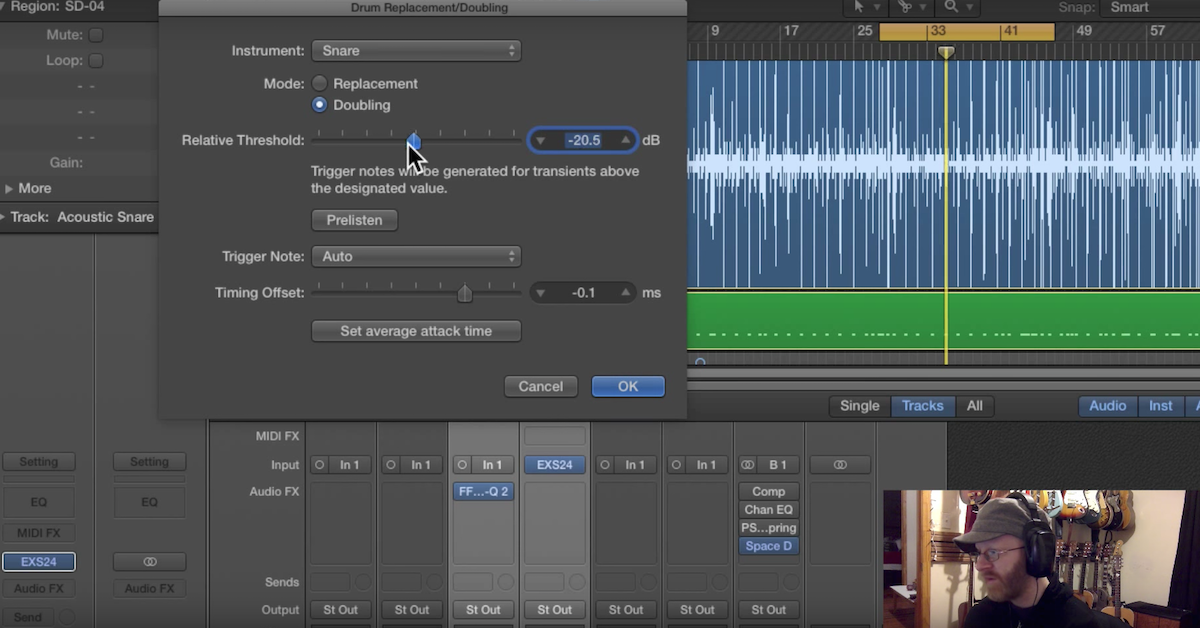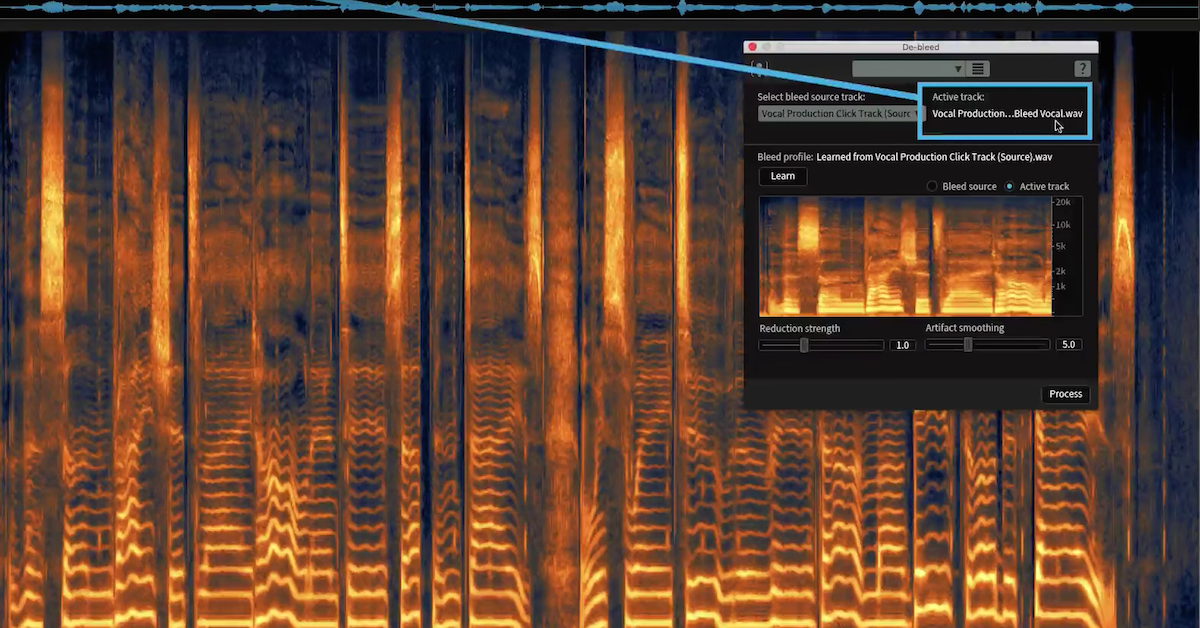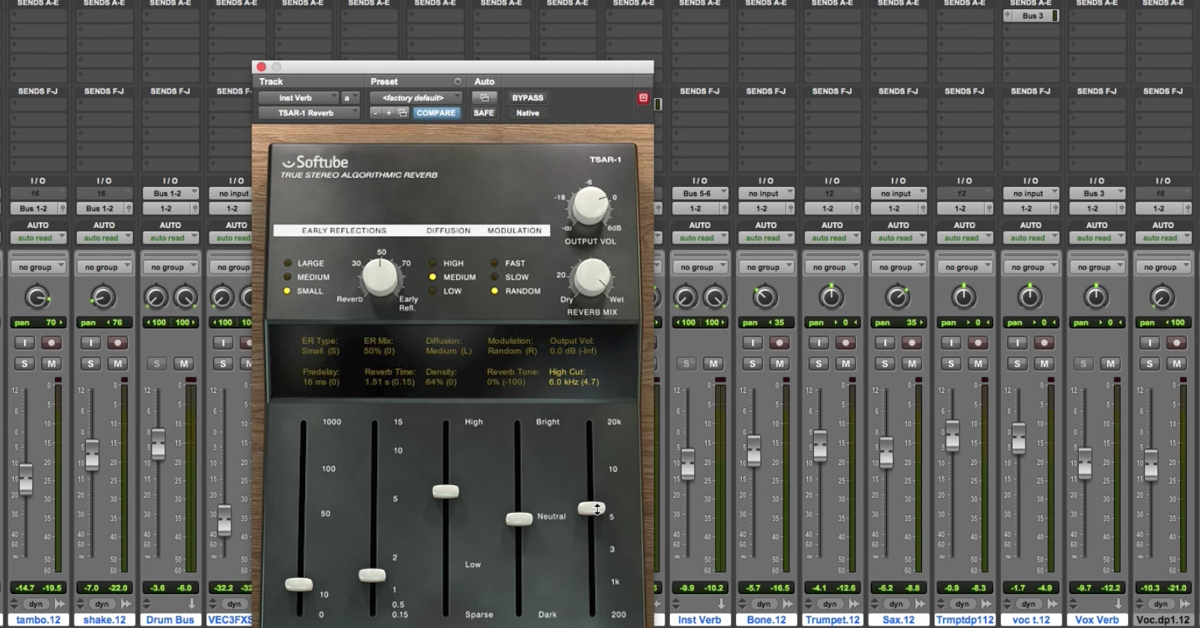4 Tips for Marrying Recordings from Different Studios
Article Content
In the last year, the number of different recording locations represented within a given session that reaches my inbox has undoubtedly gotten higher. For better or worse, long-distance collaboration has become the default for those of us making music that requires human beings to position themselves in front of a microphone. The results can often be kind of weird — hearing five or six different musicians recording themselves using different gear, in five or six different rooms is not the sound we most naturally associate with recordings of live ensembles.
Fortunately, there are more tools than ever to recreate the studio environment of your dreams right in your bedroom. We have the ability to mix and match studio gear and studio rooms themselves from around the world and across decades. Just because you weren’t able to get the band together in person doesn’t mean that somebody listening to the song has to know that! Here are a few of my go-to strategies when I need the sound of a live session but have tracks arriving from different time zones.
1. Imagine How Your Tracks Would Be Recorded in a Traditional Session
I’m going to make some assumptions about what sort of sessions someone reading this article is likely to be working with. While it’s absolutely possible that readers out there may be dealing with sessions where a full rhythm section was recorded in one studio, a group of backup vocalists at another and a string quartet at a third, I personally haven’t had any sessions like that show up in my inbox. My guess is that if you’re reading this, you’re working with material like what I’ve been seeing lately: a session full of stacked overdubs, often of the same musician harmonizing with pre-recorded tracks of themself, all recorded in (best case) proper home studios and (worst case) untreated bedrooms. Whatever the case, it’s very helpful to chart a course for your all-overdubs mix by first imagining how you might have liked the tracks to be recorded.
Let’s say there was a rhythm section (drums, bass, guitar, keys) that all tracked in a room together. In a real-world session in a commercial studio, it may be easy to get a good deal of separation on those instruments. But in this insular session, separation is only going to highlight the unnatural process, so I’m going to imagine the rhythm section was recorded in a way that would allow for some microphone bleed.
Then maybe there was a lead vocal recorded in a tight booth, with a group of backup vocalists recorded in the larger live room. If there are orchestral instruments (e.g. a horn section or a string ensemble) they might have been recorded in that same live room at a different time, or in an entirely separate live room. Maybe it was a huge scoring stage with natural, hall-like reverb.
My point here is that, unless the goal is a mix that sounds like it was recorded before about 1970, it’s very likely that there will be some separation during the recording process. All instruments being recorded live in one room at the same time is not necessarily all that common, depending on the material being recorded. The issue is that if we leave the separation unchecked, then the seams of the piecemeal recording process are really going to show. So to avoid that scenario, start by making a roadmap for a hypothetical production process. From there, we’re going to recreate it in the box.
2. Create Spaces for Groups of Instruments to Live In
Once we’ve got a sense of who recorded live with who, where and when, the next step is to rebuild those studio environments. The easiest way to do this is with reverb that models a realistic space — think room and chamber reverb. Unless your session is made of primarily orchestral instruments, a hall is not a natural choice for a recording environment.
I wrote an article about de-bedrooming bedroom recordings, and in it I suggest a few of my favorite reverbs for recreating natural spaces. If you’re unsure where to start with this process, you might find some ideas there.
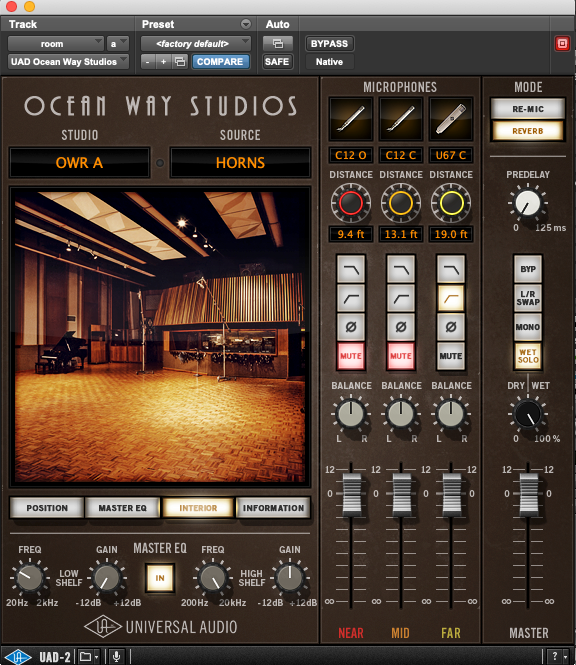
Let’s take a look at a real-world piecemeal remote recording. In the example you’ll hear below, the direction I got was to glue together a set of disparate home recordings to sound like a pop recording from the 60s. So in that case, I did end up putting all the instruments in one room. I was imagining a Wrecking Crew-esque group sitting down for a session at Western Recorders. Lucky for me, I can use UAD’s emulation of two rooms from that fabled (and still open!) studio in the form of their Ocean Way reverb.
In this track, the arrangement features a pair of saxes. In a modern production, I’d expect horns to be done as an overdub — and so I might create their own reverb send. In this fantasy 1960s session, though, I’m imagining the horns were recorded right in the room with the rhythm section, as they often would have been at the time. So I’m going to let the saxes share a reverb aux with the drums, bass, and guitar. For the vocals (which we’ll get to shortly) I’m imagining recording in a tight booth with some plate reverb added.
In a real 60s era ensemble recording session, there might also be a considerable amount of bleed from the bass amp into other mics in the room. This would create a diffuse bass sound that is a far cry from the tight, powerful low end we’re used to today. Generally, I’ve found that even when clients are aiming to recreate retro sounds and vibes, they don’t necessarily want to stray too far from the expectations of our modern ears. So yeah, the bass in that 60s pop record might be bleeding into every other mic, but in my session I’m going to have my cake and eat it too. I’ll send just enough of the bass for some realism and glue, but not so much that I muddy the mix or lose the focus of my low end. In the examples below, the bass is getting sent about 20dB less than the drums, sax, and guitar.
Here’s a snippet without my room reverb:
…and another with:
The dry mix, to my ears, feels cold, austere and lacking depth. With some room in the mix, I’m starting to believe this band recorded together a little more.
3. Process Those Spaces to Simulate Microphone Bleed
Ok, so you’ve (cleverly!) recreated a live recording environment using in the box reverb. If the goal was the traditional sort of “glue” we often look for when we dial in reverb, the work would basically be done now. But the goal here is a little more complicated than that. We’re not just smoothing out a recording, we’re really kind of trying to fool the audience. So I’d ask: what would really happen with all that microphone bleed from tracking, if tracking had happened the way I’m imagining it might have?
The answer is that the bleed permeating the tracks of the session would not be the end of the story. That bleed-soaked signal would be hitting channel strips, compressors and ultimately tape, imparting saturation every step of the way. The coloration that that sort of processing gives to microphone bleed can be an elusive but beautiful thing. It creates a pleasant, hazy halo that surrounds a recording. Done right, that mic bleed doesn’t have to be a nuisance to be “fixed” during mixing — it can be a sort of secret sauce that ties a recording together and makes it more vibrant. I would argue that the harmonic colors added by signal processing are an integral part of that recipe.
Of course, heavily processing tracks with lots of bleed does come with the risk of complicating phase relationships between the various tracks involved. Additionally, reverse engineering the phenomenon I’m describing in order to recreate it exactly in the box is very likely to be a cumbersome task that may not pay off in proportion to the time and effort it requires.
Fortunately, there are some simple solutions to bring back just a bit of that analog coloration. If it makes sense to process instruments together on a buss, that offers the easiest opportunity. Put your reverb in line before whatever other buss processing you plan to use — especially compression, tape emulation and other forms of saturation. Not only will the dynamics processing help control the reverb in a pleasant way, but you’ll be introducing harmonic color in a relatively low-effort way.
Of course, sometimes it may not make sense to buss together instruments that might share a “live recording environment.” In the case of my example, the final deliverable included stems, and that meant I needed to hand over clean, bleed-free drum, saxophone, guitar, and bass tracks (the “room buss” was delivered as its own stem). In those cases, I’m a big fan throwing some coloring plugins on after my room emulation of choice. Some simple, no-fuss saturation or your favorite tape emulation can go a long way towards subtly exciting an artificial “room.” Hearing the ambient space processed the way mic bleed would be helps trick our ears into believing they’re really hearing some musicians jamming in a room together.
Here, I filtered my “room buss,” and carved out some low-mid mud. Then I added some no-frills transformer-modeled saturation:
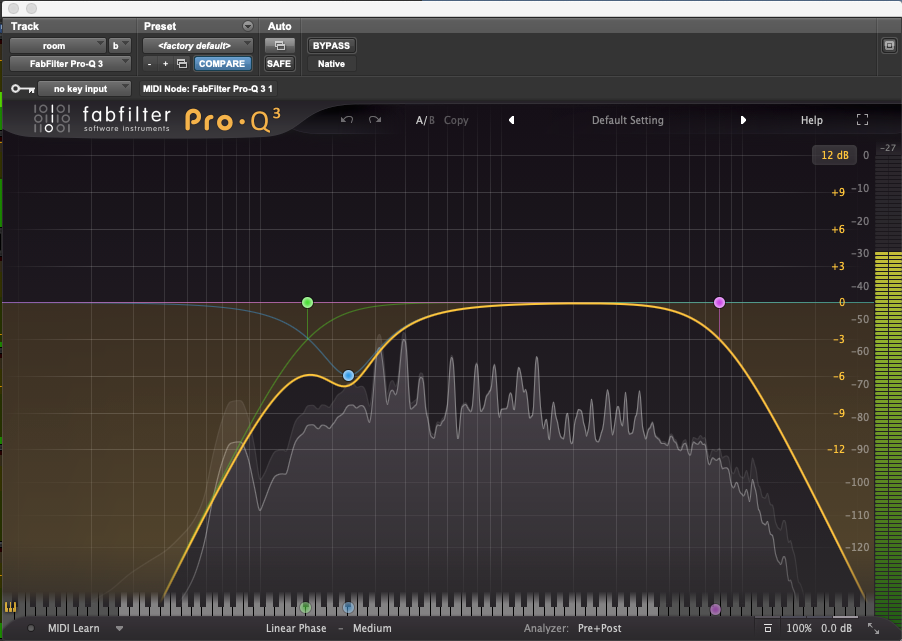
I used filtering and a low-mid bell scoop to tame the most problematic frequencies…
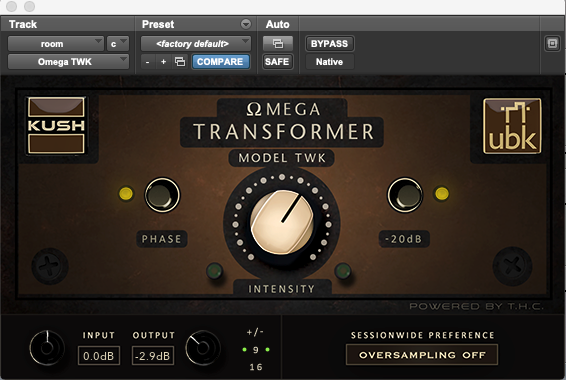
…and then cranked up some basic transformer-modeled saturation
Contrast the sound of the recording with the additional processing on the room with what you heard before.
Here’s pre-saturation:
…and post:
The change is subtle, but I hear some excitement in the room ambience that is further gelling the instruments I’m sending there.
4. Use Staggered Panning for Layered Overdubs
My final tip involves cases where one performer delivers stacked overdubs, which might be meant to be heard as a live performance by a small ensemble. It can help to create a sense of dimension and space not just with use of ambience, but also with panning.
Take as an example the vocal tracks from the piece I used above. If there were really two singers, it would be impossible for them to literally occupy the same physical space in a room. In our hypothetical session, they’d be standing next to each other, probably a few feet apart.
If you have any say on how instruments are tracked, a great way to fake this effect is to have the player stand in slightly different places as they do each take. The varying locations will affect the sound hitting the mic and give the impression of multiple musicians standing in different places. Even if you don’t have the ability to direct how tracks are recorded, however, it’s possible to recreate a similar effect using panning.
Try spacing the panning of the layered overdubs out so that they’re staggered a bit. I’m not talking about wide left-right panning, but rather, putting the stacked takes just a few degrees apart.
Here, I have both voices panned 50% left:
Then I moved one out just a bit wider, to around 70%, leaving the other at 50:
The staggered panning helps create a sense of space in the stereo field, beyond what we’re adding with reverb.
If you’re reading this thinking “wait, but if those two singers were really recording on one mic, wouldn’t they end up in the same spot in the stereo mix?” you’re right! But the goal here is to work with what we have to simulate some realism in a mix. Staggered panning helps our ears and brain recreate the feeling of a real, shared space, even if the techniques used in a traditional in-person tracking session might produce different results.
Conclusion
The strategies I’ve outlined here are, of course, mostly technical. The real challenges of working with a “band” that can’t get together in the same room include harder-to-solve musical ones, too. Musicians play differently when they aren’t able to respond to the other people they’re recording with, and without a doubt I’ve ended up doing more editing of remotely recorded tracks than I would do with live takes.
That said, I like to focus my effort on the things I can change. If you’re willing to get creative, it’s possible to do a kind of shockingly convincing impression of an in-person recording session, even if the source material was all done in bedrooms or in the box.



